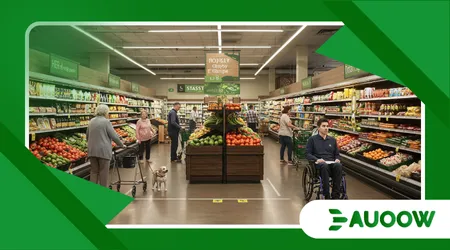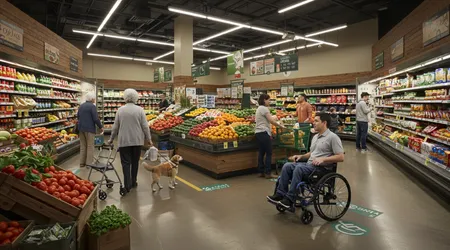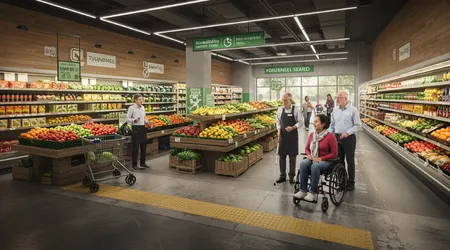Accessibility in Grocery Stores: What Needs to Change

Accessibility in grocery stores is no longer a niche concern but a pressing necessity in 2025.
As populations age and disability awareness grows, grocery stores must evolve to serve everyone equitably.
Shopping for food is a universal need, yet for millions with disabilities, it’s a maze of barrierphysical, sensory, and cognitive.
This isn’t just about compliance with laws like the ADA or the upcoming European Accessibility Act (EAA); it’s about dignity, independence, and inclusion.
Why should someone’s ability to buy groceries depend on their mobility or vision?
This article dives into the gaps in current grocery store accessibility, offering practical solutions and real-world examples to spark change.
From navigation challenges to checkout frustrations, we’ll explore what’s broken and how to fix it, grounded in today’s realities.
The stakes are high. According to the CDC, 26% of U.S. adults live with a disability, and globally, over 1 billion people face similar challenges.
Grocery stores, as essential community hubs, can’t afford to lag behind. Yet, many still do. Narrow aisles, unreachable shelves, and inaccessible digital tools create daily struggles.
Meanwhile, innovations like IKEA’s live navigation tools for blind shoppers show what’s possible when inclusion drives design.
This piece argues for a reimagined grocery experience one that prioritizes accessibility in grocery stores through intentional changes in layout, technology, and staff training.
Let’s unpack the problems and chart a path forward.
The Physical Maze: Navigating Store Layouts
Grocery store layouts often feel like obstacle courses for those with mobility issues. Narrow aisles, cluttered displays, and high shelves exclude wheelchair users and others.
The ADA mandates 36-inch-wide aisles, but compliance is spotty, especially in older stores. Shoppers with mobility aids frequently get stuck or can’t reach products.
Space isn’t the only issue. Heavy doors at entrances and poorly placed carts block pathways.
For example, Maria, a wheelchair user in Chicago, shared how she once abandoned her shopping because a store’s entrance had no automatic door.
++ Top Mobility Aids for Small Spaces and Tight Budgets
Solutions exist: wider aisles, automatic doors, and clear signage can transform the experience. Stores like Wegmans have started implementing these, but it’s not universal.
Another overlooked barrier is shelf height. Products placed above 48 inches are unreachable for many. Adjustable shelves or staff assistance protocols could help.
In 2025, retailers must prioritize universal design principles to ensure accessibility in grocery stores isn’t an afterthought. Physical access is the foundation of inclusion.

Sensory Overload: Supporting Visual and Auditory Needs
For visually or hearing-impaired shoppers, grocery stores can be disorienting. Dim lighting, tiny price tags, and lack of braille signage create hurdles.
Blind shoppers like James in Seattle rely on apps like Be My Eyes, but stores rarely integrate such tools. Clear, large-print labels and braille options are critical.
Auditory challenges are just as real. Deaf shoppers struggle with announcements or cashier interactions. Stores could adopt visual alerts or train staff in basic sign language.
IKEA’s multilingual voice guidance for in-store navigation sets a precedent. Why can’t grocery chains follow suit?
Read more: How to Navigate Public Transit with a Visual Impairment
Sensory-friendly hours, like those trialed by Tesco, reduce noise and crowds, benefiting neurodiverse shoppers too.
Technology offers solutions. Digital shelf tags with QR codes linking to audio descriptions could empower blind shoppers.
In 2025, accessibility in grocery stores demands sensory-inclusive design. Retailers must act to make stores navigable for all.
Cognitive and Neurodiverse Challenges: Simplifying the Experience
Cognitive disabilities and neurodiversity add another layer of complexity. Overwhelming choices, unclear signage, and chaotic layouts can trigger anxiety or confusion.
Autistic shoppers, for instance, may find fluorescent lights or crowded aisles unbearable. Stores must simplify without patronizing.
Clear, icon-based signage helps. Walmart’s sensory-friendly hours, with dimmed lights and no music, are a step forward.
But more is needed like staff trained to recognize and assist without judgment. For example, a UK chain’s “quiet hour” initiative saw a 30% increase in autistic shoppers’ satisfaction.
Checkout processes also need rethinking. Self-checkouts often confuse those with cognitive impairments due to complex interfaces.
Human-assisted lanes with patient staff can make a difference. Prioritizing accessibility in grocery stores means designing for mental clarity and comfort, ensuring everyone can shop with confidence.
Digital Barriers: The Online Shopping Gap
Online grocery shopping surged in 2025, but digital platforms often fail accessibility standards.
Websites with poor screen-reader compatibility or cluttered interfaces exclude visually impaired users.
The EAA, effective June 2025, mandates digital accessibility, yet only 25% of businesses are fully prepared, per A1 Retail Magazine.
Consider Sarah, a blind shopper who abandoned an online order because the store’s app lacked alt-text for images.
WCAG 2.1 guidelines clear fonts, alt-text, and keyboard navigation aren’t optional. Stores like Whole Foods have improved, but smaller chains lag.
Mobile apps must prioritize thumb-friendly navigation and voice commands.
Delivery systems also falter. Unclear delivery instructions or inaccessible tracking exclude those with cognitive or sensory impairments.
Seamless digital accessibility in grocery stores is non-negotiable. Retailers must invest in inclusive tech to meet modern expectations.
Staff Training: The Human Elemen
Even the best-designed stores fall short without trained staff. Employees often lack knowledge to assist disabled shoppers effectively.
A 2024 study by the National Disability Institute found 60% of retail workers received no accessibility training. This gap undermines accessibility in grocery stores.
Training should cover physical assistance, communication with deaf or blind customers, and sensitivity to neurodiverse needs.
For instance, a trained employee could guide a blind shopper using verbal cues, as seen in some ALDI stores. Role-playing scenarios during onboarding can build confidence.
Empathy matters too. Staff must understand that disabilities vary some visible, others not.
Regular workshops and feedback from disabled shoppers can refine skills. In 2025, human connection remains key to making accessibility in grocery stores a reality.
Policy and Advocacy: Driving Systemic Change
Accessibility isn’t just a store-level issue; it’s a policy challenge. While the ADA sets standards, enforcement is inconsistent.
The EAA’s 2025 deadline pushes European retailers, but U.S. progress stalls without similar mandates. Advocacy groups like the National Federation of the Blind demand stricter compliance.
Local governments can incentivize retrofits through tax breaks. For example, California’s 2024 accessibility grants helped small grocers install ramps.
Shoppers must also advocate boycotts or social media campaigns can pressure chains. ALDI’s 225 new U.S. stores in 2025 could set a benchmark if built with accessibility first.
Data drives change. Table 1 below shows common barriers and solutions, highlighting where policy can focus. Systemic shifts ensure accessibility in grocery stores becomes standard, not exceptional.
| Barrier | Solution | Impact |
|---|---|---|
| Narrow aisles | Widen to 36+ inches | Improves mobility access |
| High shelves | Lower or adjustable shelves | Enhances reachability |
| Inaccessible websites | WCAG 2.1 compliance | Boosts digital inclusion |
| Untrained staff | Mandatory accessibility training | Increases shopper confidence |
Economic and Social Benefits: Why Accessibility Pays
Investing in accessibility in grocery stores isn’t charity it’s smart business. Accessible stores attract loyal customers, including the 26% of U.S. adults with disabilities.
A 2024 McKinsey report estimated accessible retail could unlock $1 trillion in global spending power. Why ignore that?
Socially, inclusive stores foster community. When a store accommodates a wheelchair user, it signals respect for all.
Target’s accessible carts for kids with disabilities, for instance, went viral for their heartwarming impact.
Contrast this with a store ignoring accessibility like leaving a customer stranded in a cluttered aisle, as if their needs are an inconvenience.
Brand reputation also benefits. Social media amplifies stories of inclusion or failure.
In 2025, retailers prioritizing accessibility gain trust and market share. It’s a win-win, proving that doing good is good business.
A Path Forward: Practical Steps for Retailers

Retailers can’t wait for mandates they must act now. Start with audits: assess aisles, shelves, and digital platforms against ADA and WCAG standards.
Engage disabled shoppers for feedback, as Tesco did with its accessibility panel. Small changes, like adding braille price tags, yield big results.
Technology is a game-changer. QR codes linking to audio product details or apps guiding blind shoppers are feasible in 2025.
ALDI’s expansion offers a chance to pilot these. Staff training, meanwhile, should be ongoing, not a one-off. Imagine a store where every employee knows how to assist a beacon of inclusion.
Finally, collaborate with advocacy groups. Partnerships with organizations like the American Foundation for the Blind ensure solutions are practical.
Accessibility in grocery stores starts with commitment retailers must choose to lead.
Conclusion: A Call to Redefine Grocery Shopping
Grocery shopping should be a right, not a privilege. In 2025, accessibility in grocery stores remains a patchwork of progress and neglect.
From cramped aisles to inaccessible apps, the barriers are clear but so are the solutions.
Retailers like Wegmans and Tesco show what’s possible when inclusion drives design. Yet, too many stores lag, leaving disabled shoppers frustrated or excluded.
This isn’t just a logistical issue; it’s a moral one. Every shopper deserves dignity and independence.
Think of accessibility like a bridge: build it right, and everyone crosses safely. Retailers, policymakers, and shoppers must work together auditing stores, enforcing standards, and amplifying voices.
The 26% of Americans with disabilities, and billions worldwide, aren’t a niche market they’re part of every community.
Let’s demand stores that welcome all, not just the able-bodied. The future of grocery shopping depends on it.
Frequently Asked Questions
Q: What are the main barriers to accessibility in grocery stores?
A: Narrow aisles, high shelves, inaccessible websites, and untrained staff are common hurdles, often violating ADA or EAA standards.
Q: How can technology improve accessibility in grocery stores?
A: Apps with audio descriptions, braille signage, and WCAG-compliant websites empower blind, deaf, and mobility-impaired shoppers.
Q: Are there legal requirements for grocery store accessibility?
A: Yes, the ADA in the U.S. and the EAA in Europe (effective June 2025) mandate physical and digital accessibility.
Q: How can shoppers advocate for better accessibility?
A: Share experiences on social media, join advocacy groups, or provide feedback directly to stores to push for change.
